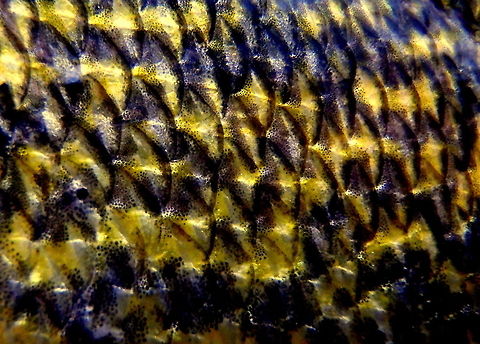
Appearance
Walleyes are largely olive and gold in colour . The dorsal side of a walleye is olive, grading into a golden hue on the flanks. The olive/gold pattern is broken up by five darker saddles that extend to the upper sides. The colour shades to white on the belly. The mouth of a walleye is large and is armed with many sharp teeth. The first dorsal and anal fins are spinous, as is the operculum. Walleyes are distinguished from their close cousin the sauger by the white colouration on the lower lobe of the caudal fin which is absent on the sauger. In addition, the two dorsals and the caudal fin of the sauger are marked with distinctive rows of black dots which are absent from or indistinct on the same fins of walleyes.Naming
The common name, "walleye", comes from the fact that the fish's eyes point outward, as if looking at the walls. In medicine, the term "walleyed" is used to refer to lateral ''strabismus'', where the pupil deviates outward. This externally facing orientation of the eyes gives anglers an advantage in the dark because there is a certain eyeshine given off by the eye of the walleye in the dark, similar to that of lions and other night dwelling animals. This "eyeshine" is the result of a light-gathering layer in the eyes called the ''tapetum lucidum'', which allows the fish to see well in low-light conditions. In fact, many anglers look for walleyes at night since this is when major feeding patterns occur. The fish's eyes also allow them to see well in turbid waters , which gives them an advantage over their prey. Thus, walleye anglers will commonly look for days and locations where there is a good "walleye chop" . This excellent vision also allows the fish to populate the deeper regions in a lake, and they can often be found in deeper water, particularly during the warmest part of the summer.Reproduction
In most of the species' range, the majority of male walleyes mature at age three or four. Females normally mature about a year later. Adults migrate to tributary streams in late winter or early spring to lay eggs over gravel and rock, although there are open water reef or shoal spawning strains as well. Some populations are known to spawn on sand or on vegetation. Spawning occurs at water temperatures of 6 to 10 °C . A large female can lay up to 500,000 eggs, and no care is given by the parents to the eggs or fry. The eggs are slightly adhesive and fall into spaces between rocks. The incubation period for the embryos is temperature-dependent, but generally lasts from 12 to 30 days. After hatching, the free-swimming embryo spends about a week absorbing the relatively small amount of yolk. Once the yolk has been fully absorbed, the young walleye begins to feed on invertebrates, such as fly larvæ and zooplankton. After 40 to 60 days, juvenile walleyes become piscivorous. Thenceforth, both juvenile and adult walleyes eat fish almost exclusively, frequently yellow perch or ciscoes, moving onto bars and shoals at night to feed. Walleye also feed heavily on crayfish, minnows, and leeches.Food
The walleye is considered to be a quite palatable freshwater fish, and, consequently, is fished recreationally and commercially for food. Because of its nocturnal feeding habits, it is most easily caught at night using live minnows or lures that mimic small fish. In Minnesota the walleye is often fished for in the late afternoon on windy days. Most commercial fisheries for walleye are situated in the Canadian waters of the Great Lakes.Cultural
The walleye is the state fish of Minnesota and South Dakota and the official fish of Saskatchewan. It is very popular with Minnesota residents; more walleye is eaten in Minnesota than in any other jurisdiction of the United States. Both Garrison and Baudette, Minnesota, claim to be the "Walleye Capital of the World," each with a large statue of the fish.Winnipeg, Manitoba considers the walleye its most important local fish. Icelandic fishermen in Lake Winnipeg have traditionally supplied the Winnipeg market.
References:
Some text fragments are auto parsed from Wikipedia.